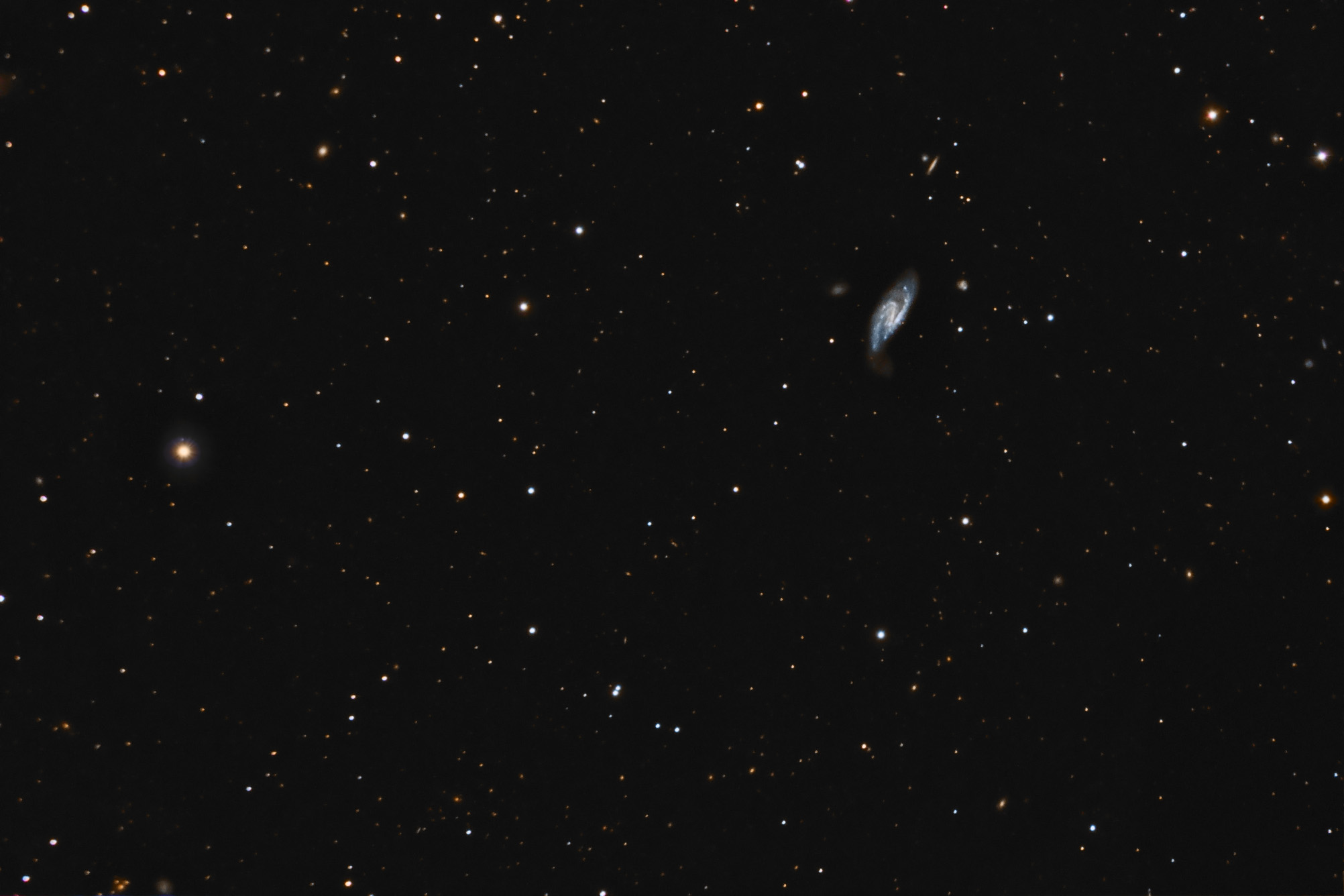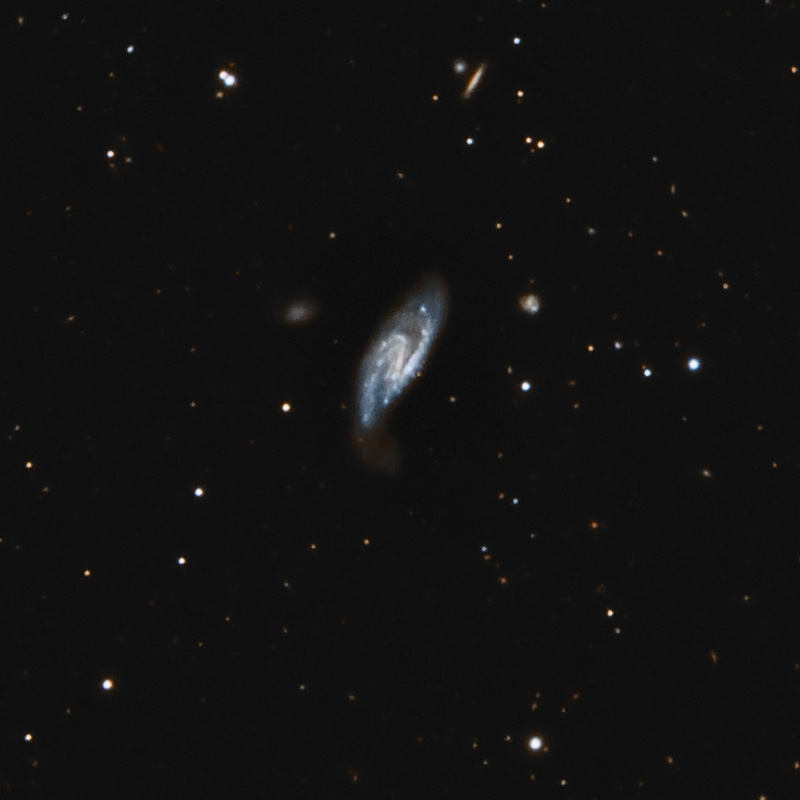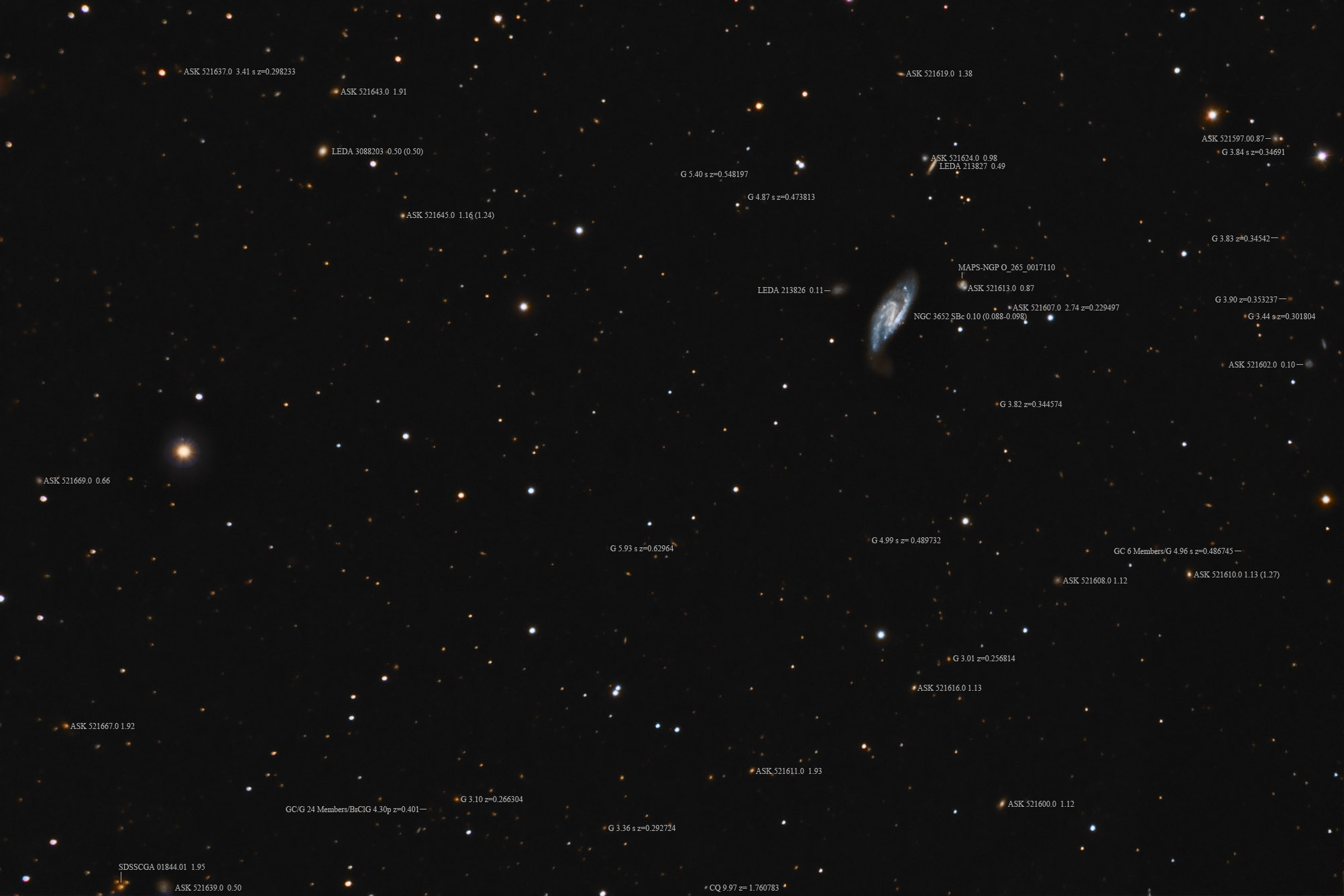Object name: NGC3652 NGC 3675 is a beautiful but rarely imaged flocculent galaxy in Ursa Major. By redshift, it is about 46 million light-years distant. Other measurements, mostly Tully-Fisher, range from 41 to 65 million light-years. The one claimed to be most accurate in a 2009 paper says 54 million light-years. I found little agreement beyond this. It is classed as SA(s)b;HII LINER. I'm a bit puzzled over the HII as the only note at NED mentioning HII said the regions were less than 2" across and indicated they considered them a minor feature. It is tilted rather strongly toward an edge on view. This means we see the dust lanes on the near side much better than those of the far side. In fact, the galaxy has a large halo that further hides the far side from view. I've applied considerable processing to this region to bring out detail usually hidden by the halo in the few images of this galaxy I found on the net. Even the Sloan Survey image has difficulty with detail of the far side. The core seems to have no real bulge. It even appears recessed as if the flocculent arms and dust lanes extend further above and below the disk's plane than does the core. This is likely an illusion due to my processing to bring out spiral structure right to the very center, but one I can't seem to shake.
My reason for imaging it is the odd outer dust lane on the east side as well as the extensive outer faint regions. Are they plumes? Most images fail to show the outer regions with many stopping at the dust band not even realizing it is a band rather than the edge of the galaxy yet it is bright enough to show color rather well.
It was discovered by William Herschel on January 14, 1788. It is in the original H400 program. My log for that dated May 4, 1984 on an excellent night with a 12.5" f/5 scope at up to 150x reads: " Interesting tilted spiral, much detail seen in the arms. Starlike nucleus. 11th magnitude. A very good object!!"
There's a really strange galaxy above NGC 3675. It is SDSS J112622.06+434124.4. It has one arm on the east side mostly detached from the core. There's nothing on it in the literature. I'd love to see what Hubble's view of it would be. There are several galaxy clusters in the image. The one due east of NGC 3675 is WHL J112649.0+433441. The BCG is listed at 4.05 billion light-years but the cluster with the same location has a photographically determined redshift of 4.25 billion light-years. I consider the former more likely the more reasonable estimate. To the west and a bit, north is the 22 member group WHL J112459.4+433810. Right near the northwest end of NGC 3675 is the small 7 member group WHL J112557.7+433919. Virtually my entire field is covered by ZwCl 1122.8+4351. It is listed as being 19 minutes across and containing 99 members. Its morphology is listed as open which means it lacks any pronounced concentration of galaxies. Yet another cluster is centered just off the east edge of my image. Several of its members are in the frame so I drew a line to indicate where the center is just a few pixels beyond the edge of the image. The cluster is GMBCG J171.91396+43.71478. The BCG is listed at 2.5 billion light-years with the cluster's photographic distance at 2.6. Again, the photographic determination is usually less accurate so I went with the 2.5 figure in the image.
The vast majority of galaxies in the field had no redshift values at NED. All that did are listed in the annotated image.
I see by the current Astronomy Magazine the term "flocculent galaxy" was coined by Debra Meloy Elmegreen the current president of the American Astronomical Society. I didn't realize it was such a new term. (Edit: This was written on July 2, 2012)
I've also included the Sloan Survey image of this galaxy. It was the only image I found on the net that indicated there was more to the galaxy than all the other images I found were showing.
14" LX200R @ f/10, L=4x10' RGB=2x10', STL-11000XM, Paramount ME Related Designation(s):2MASS J11223902+3745543, 2MASX J11223905+3745541, 2MASXi J1122390+374554, AKARI J1122386+374601, ARK 291, ASK 521615.0, CGCG 1119.9+3802, CGCG 185-049, FIRST J112238.8+374545, HDCE 0648 NED001, IRAS 11199+3802, IRAS F11199+3802, LDCE 0805 NED002, LGG 236:[G93] 002, MCG +06-25-055, NGC 3652, NGC3652, NVSS J112238+374555, PGC 034917, SDSS J112239.02+374554.3, SDSS J112239.03+374554.3, SDSS J112239.03+374554.4, SDSS J112239.12+374554.4, UGC 06392, USGC U383 NED03, UZC J112239.0+374554, [M98j] 123 NED02, | | 

